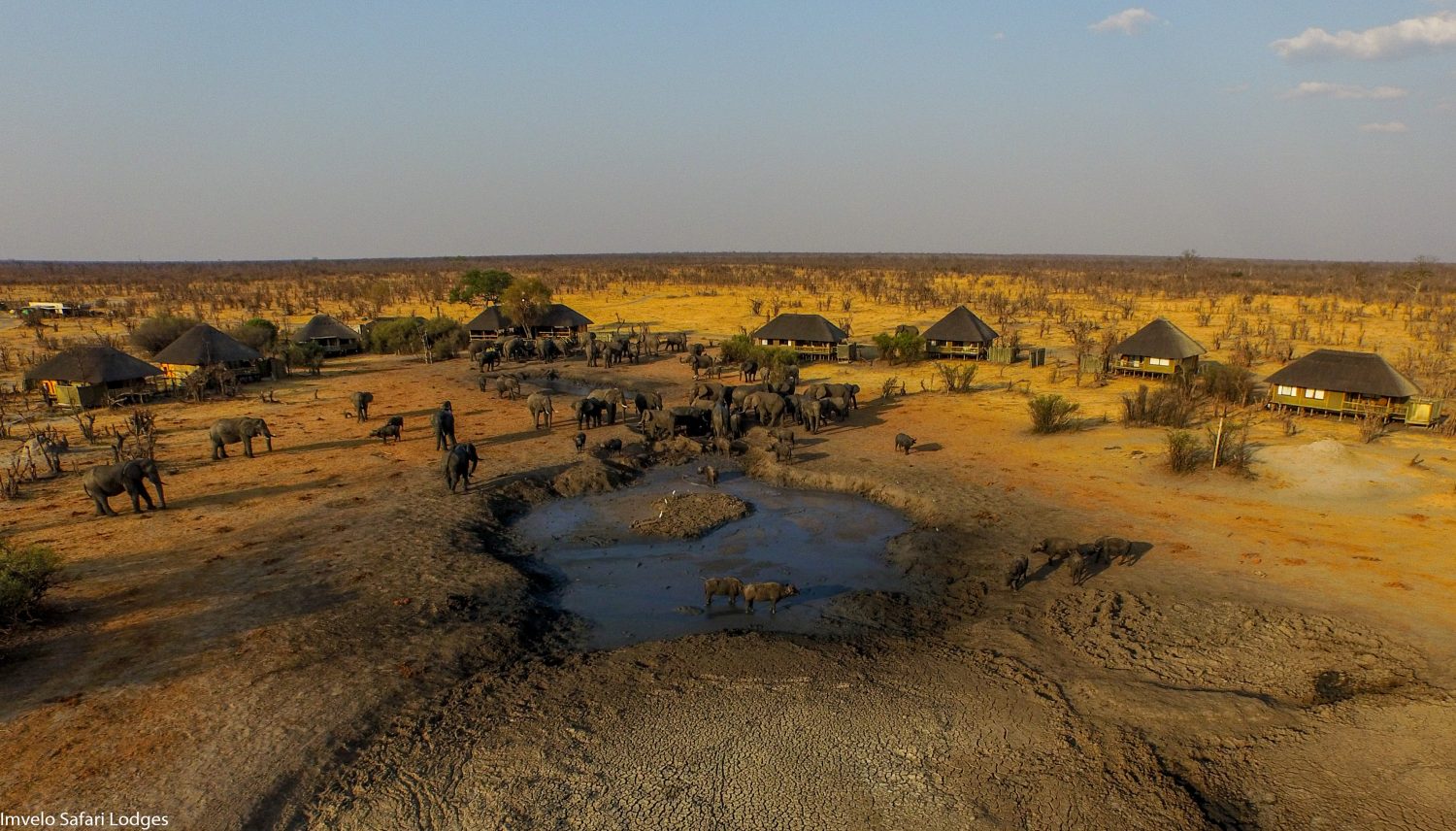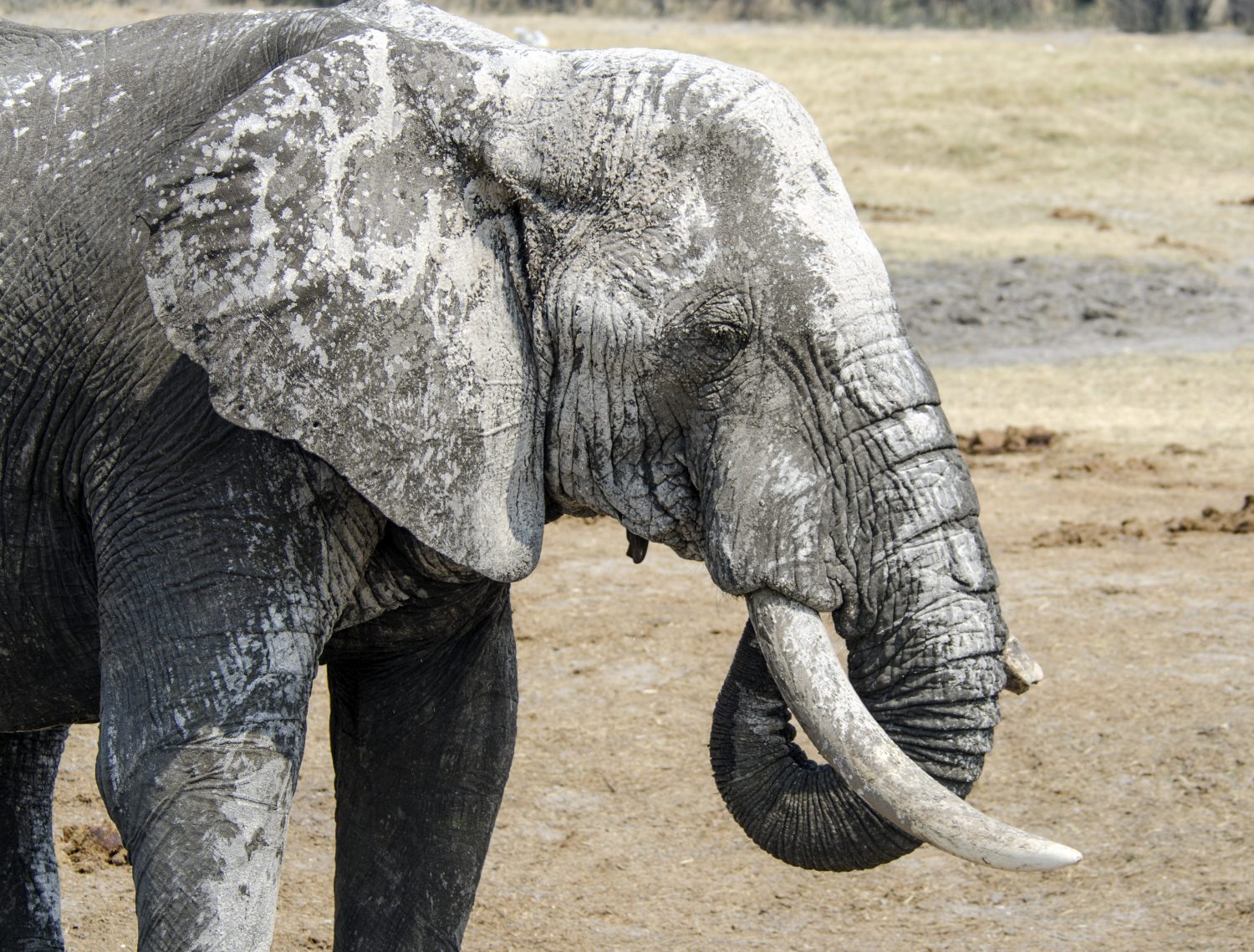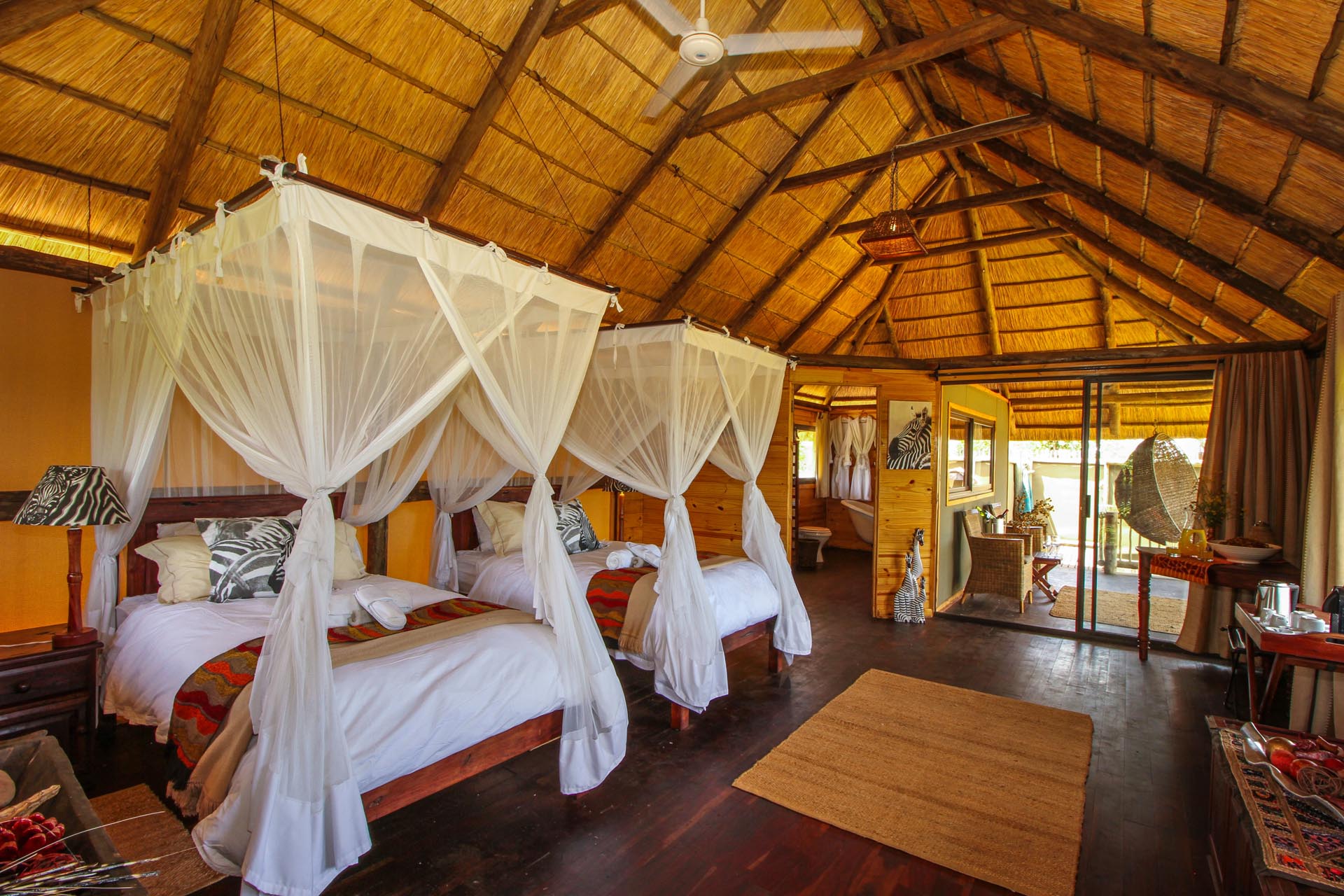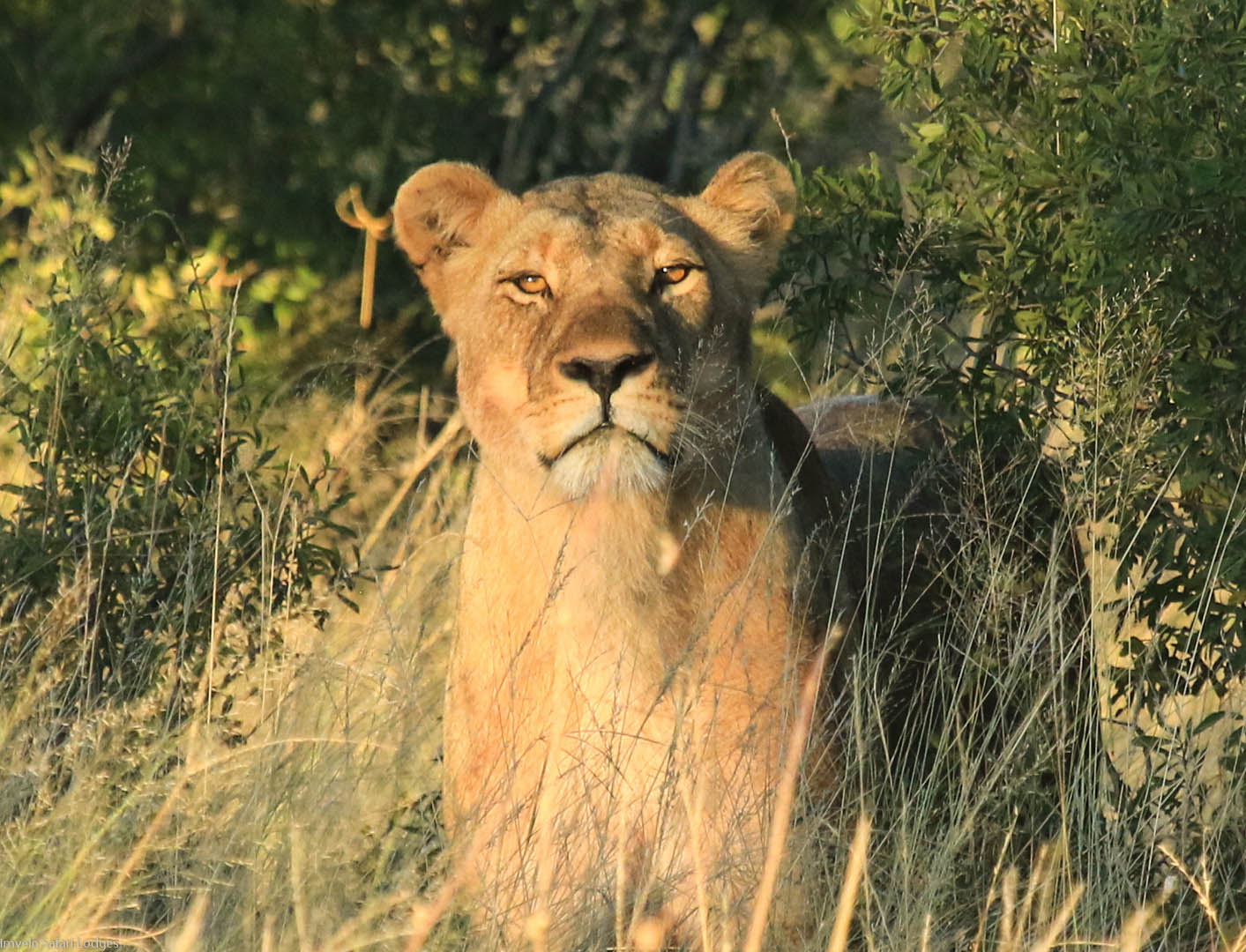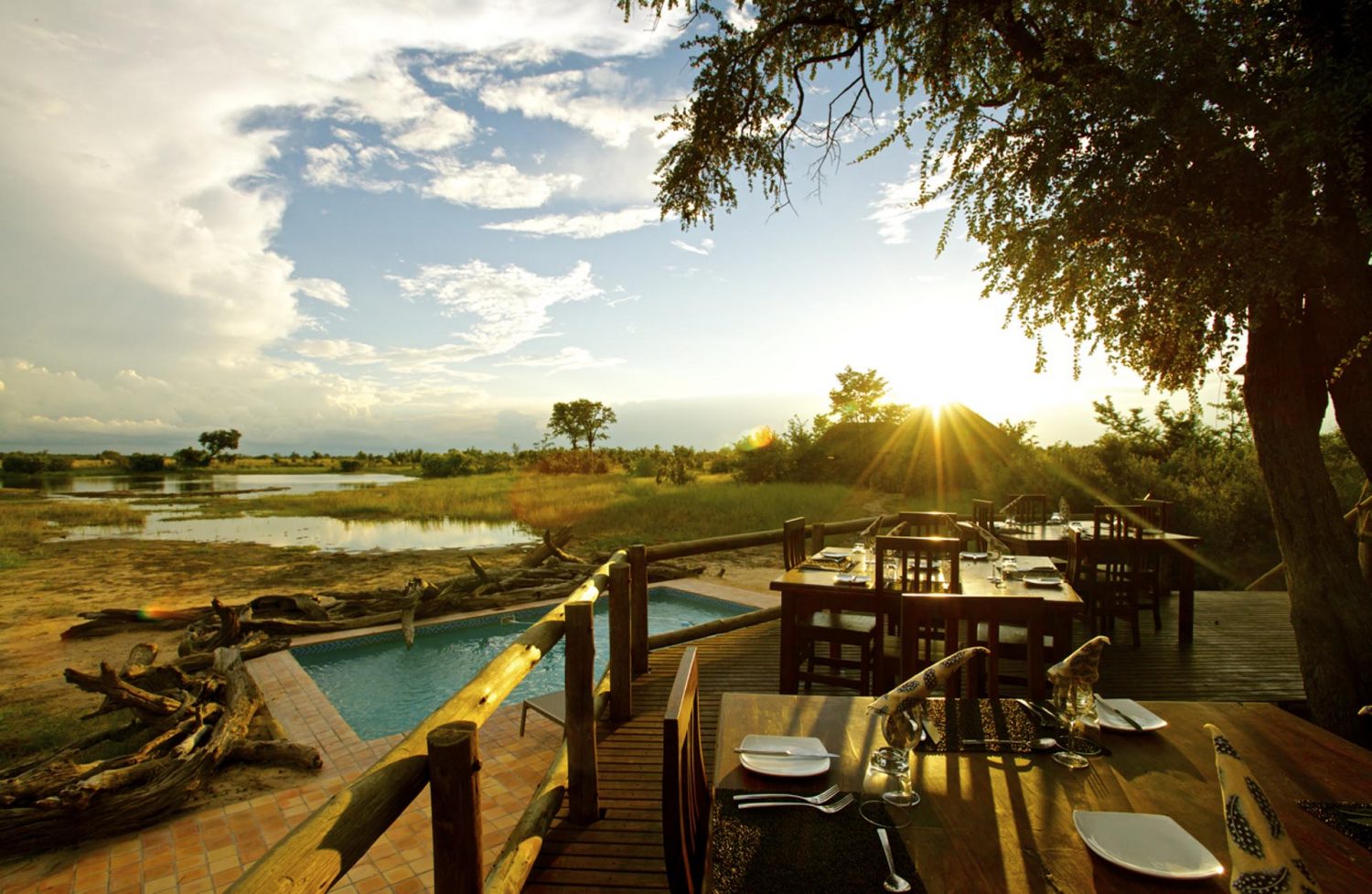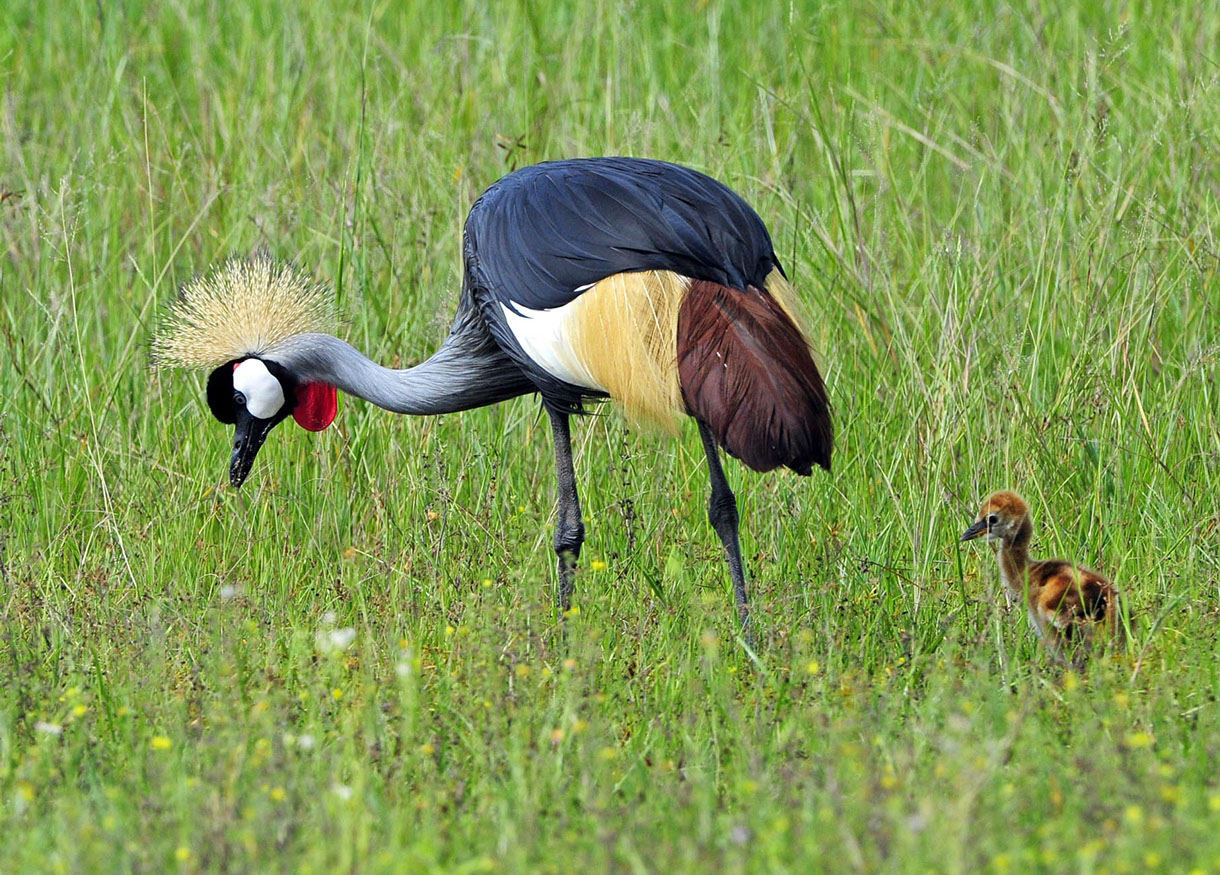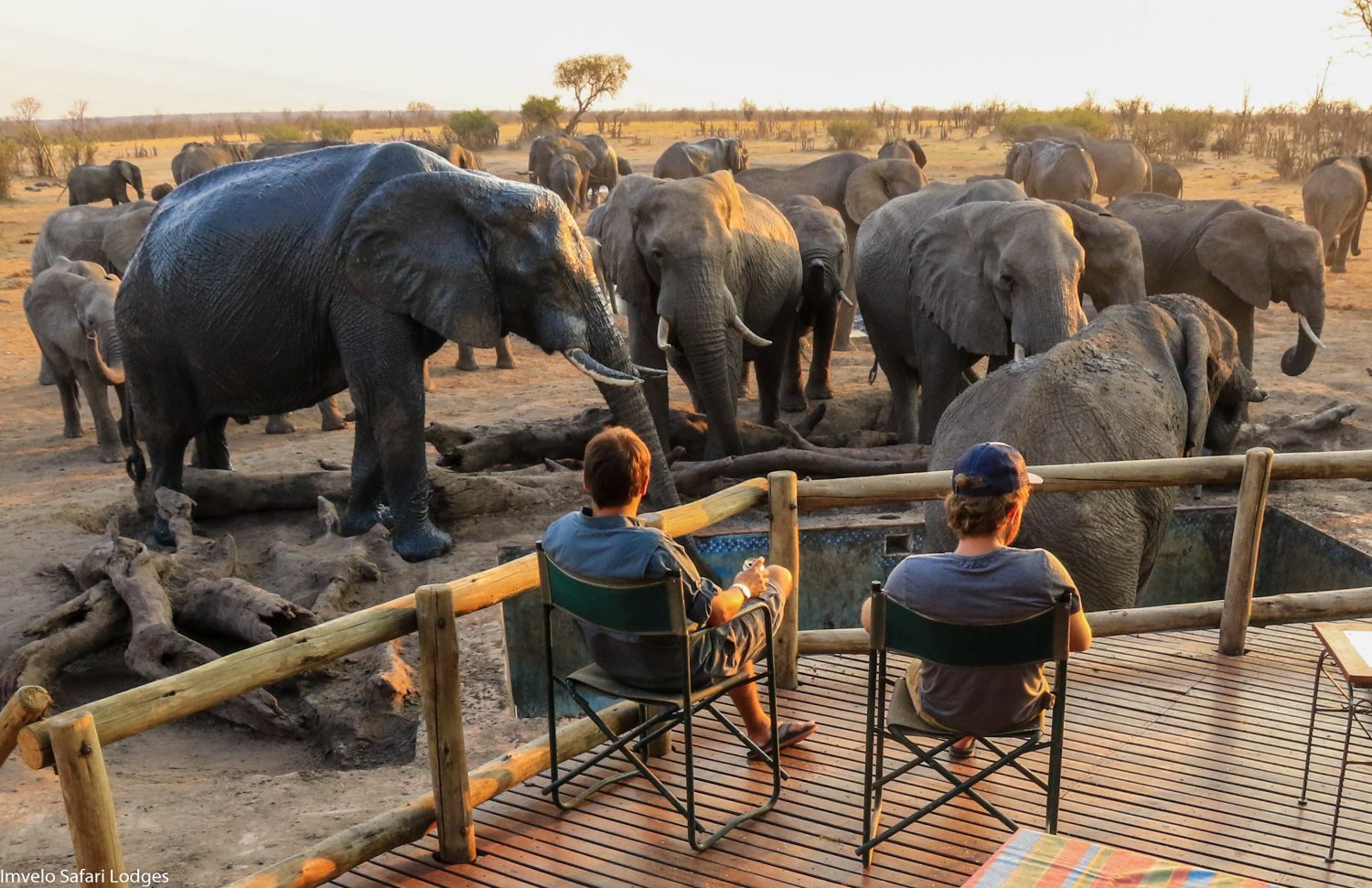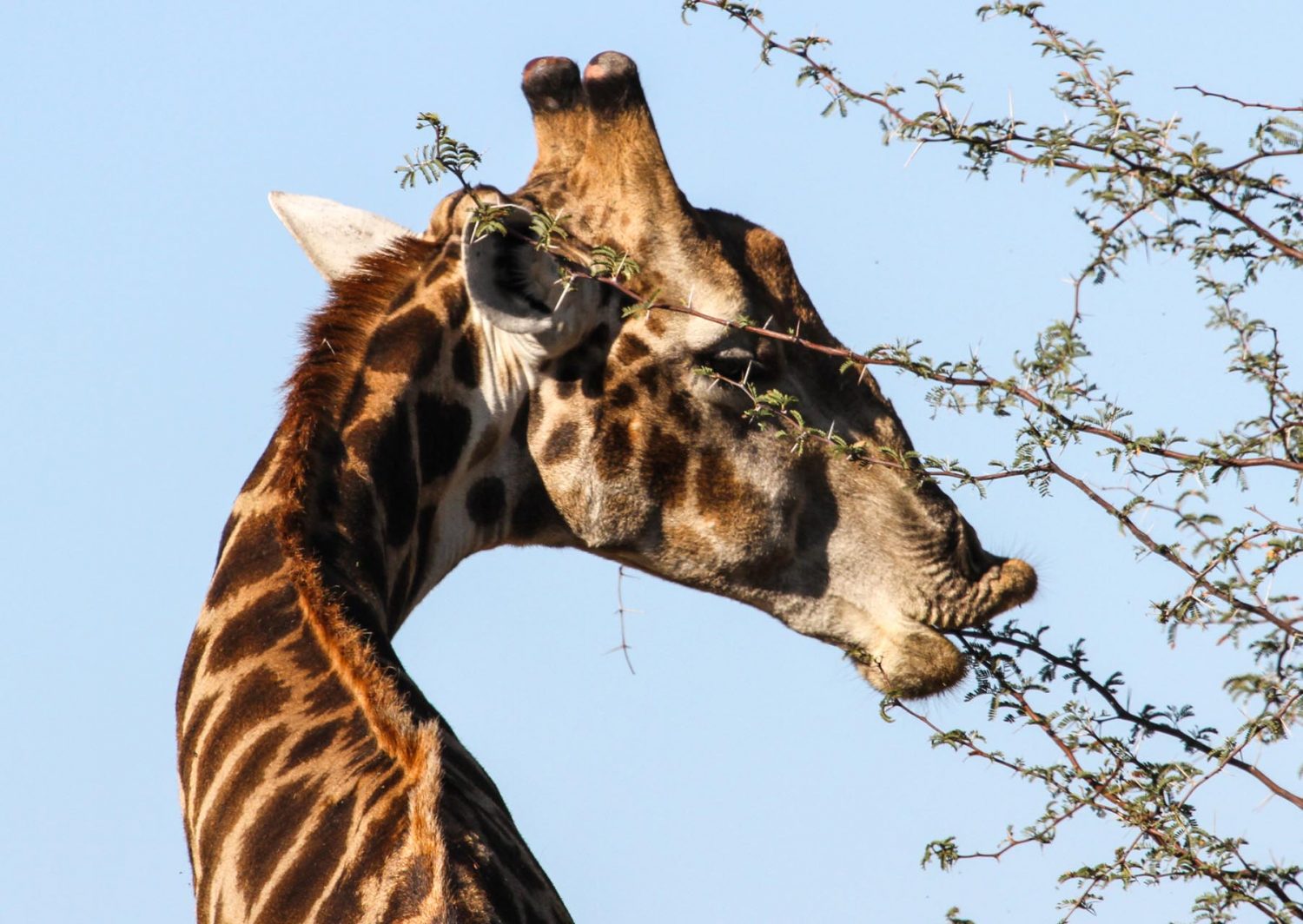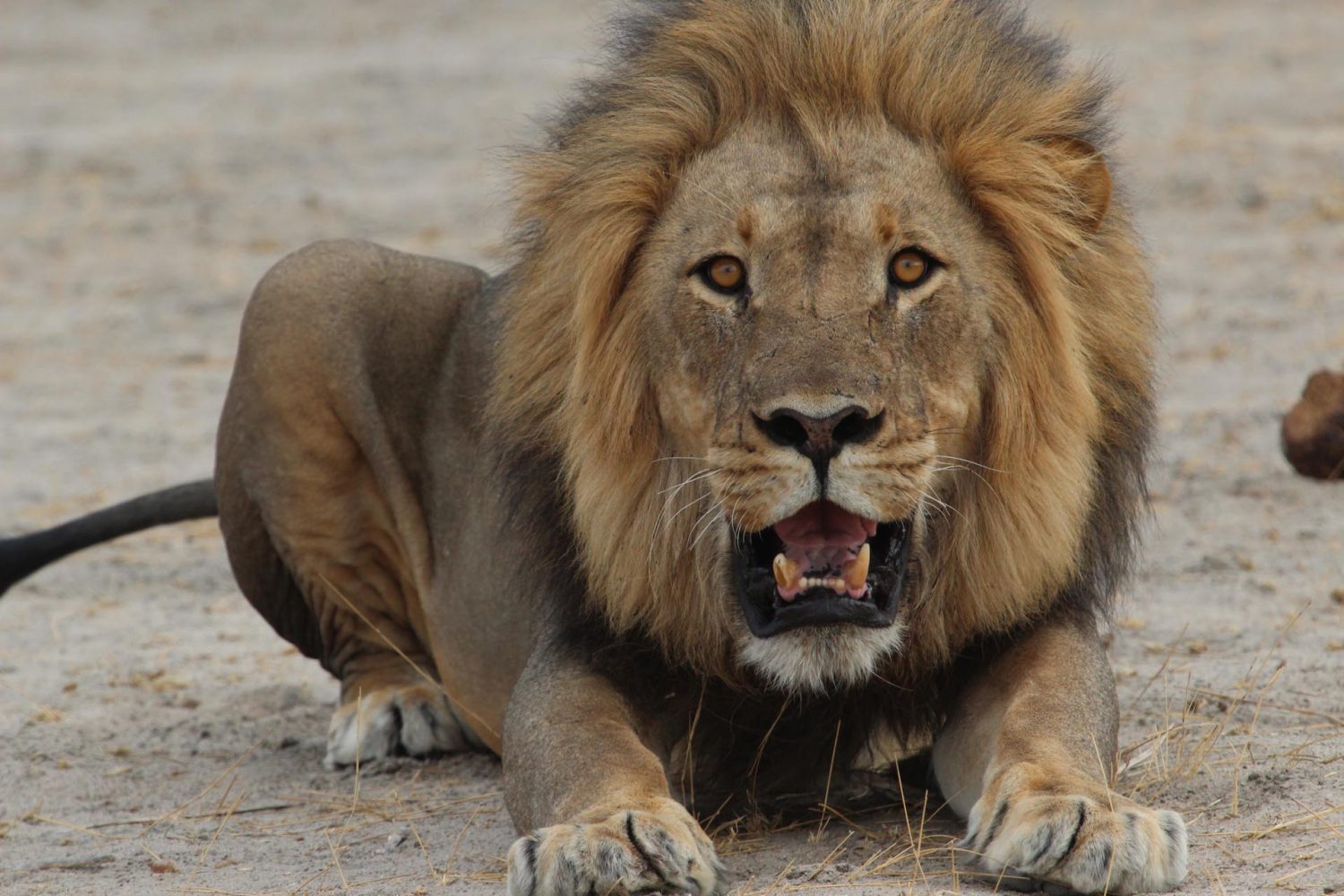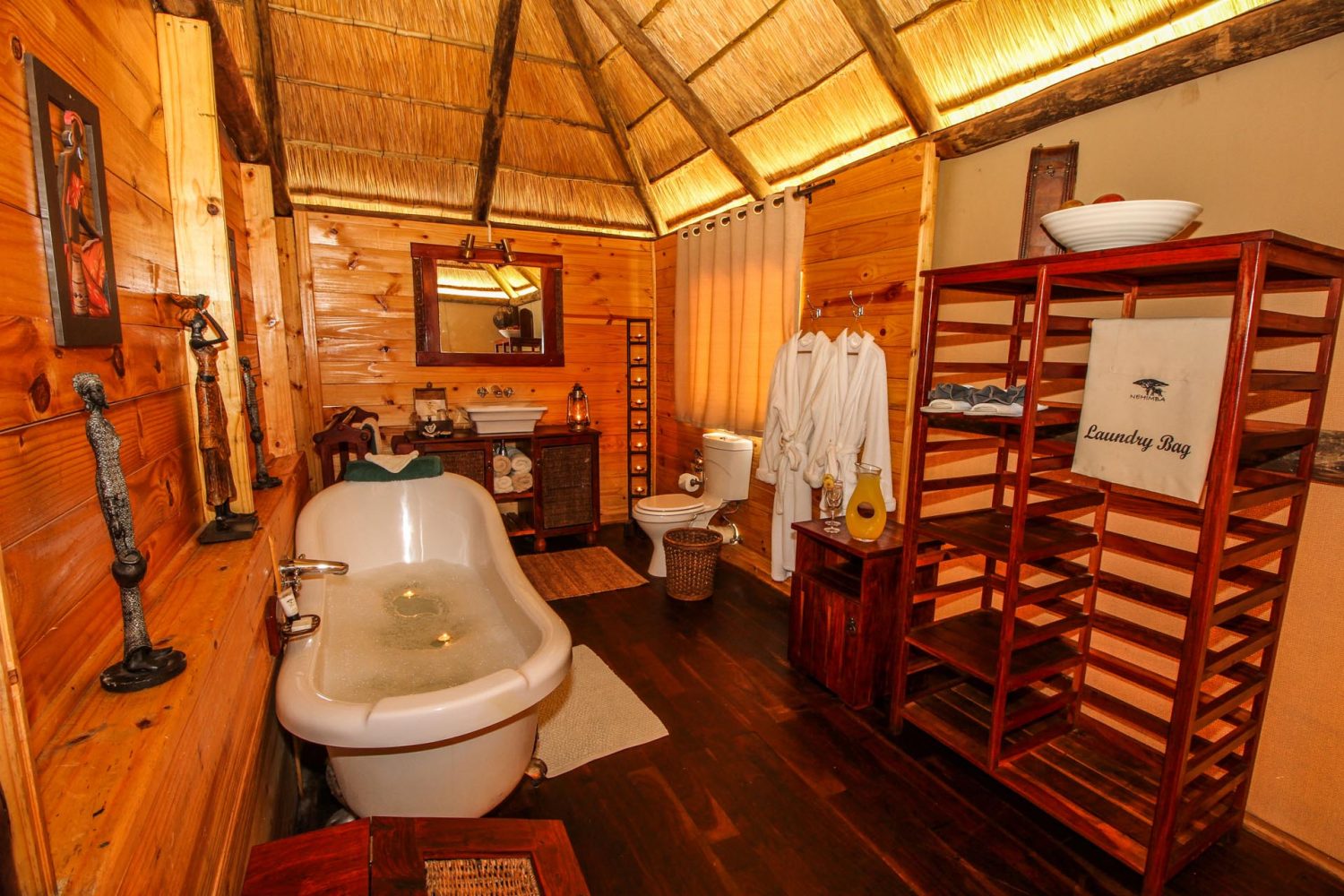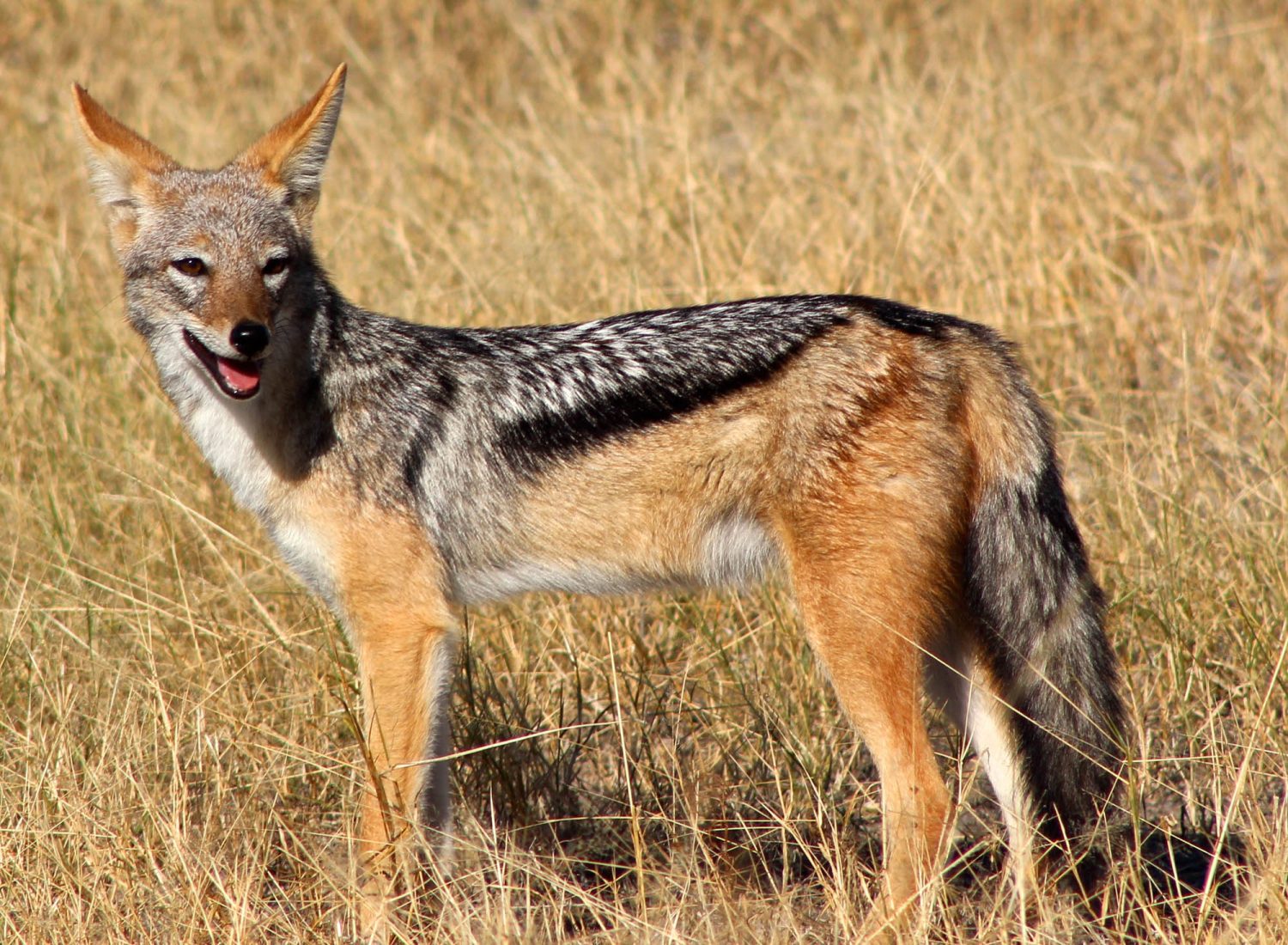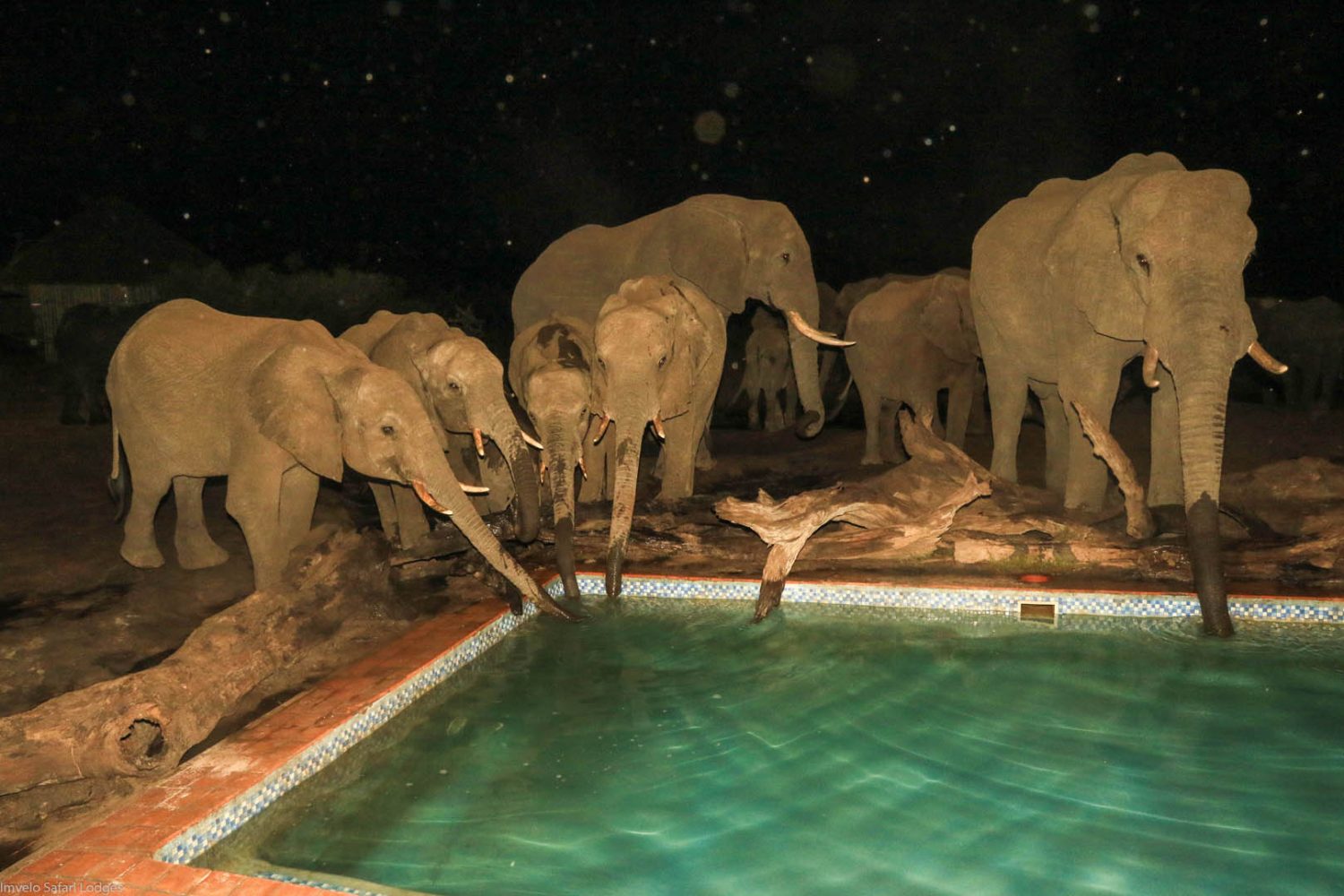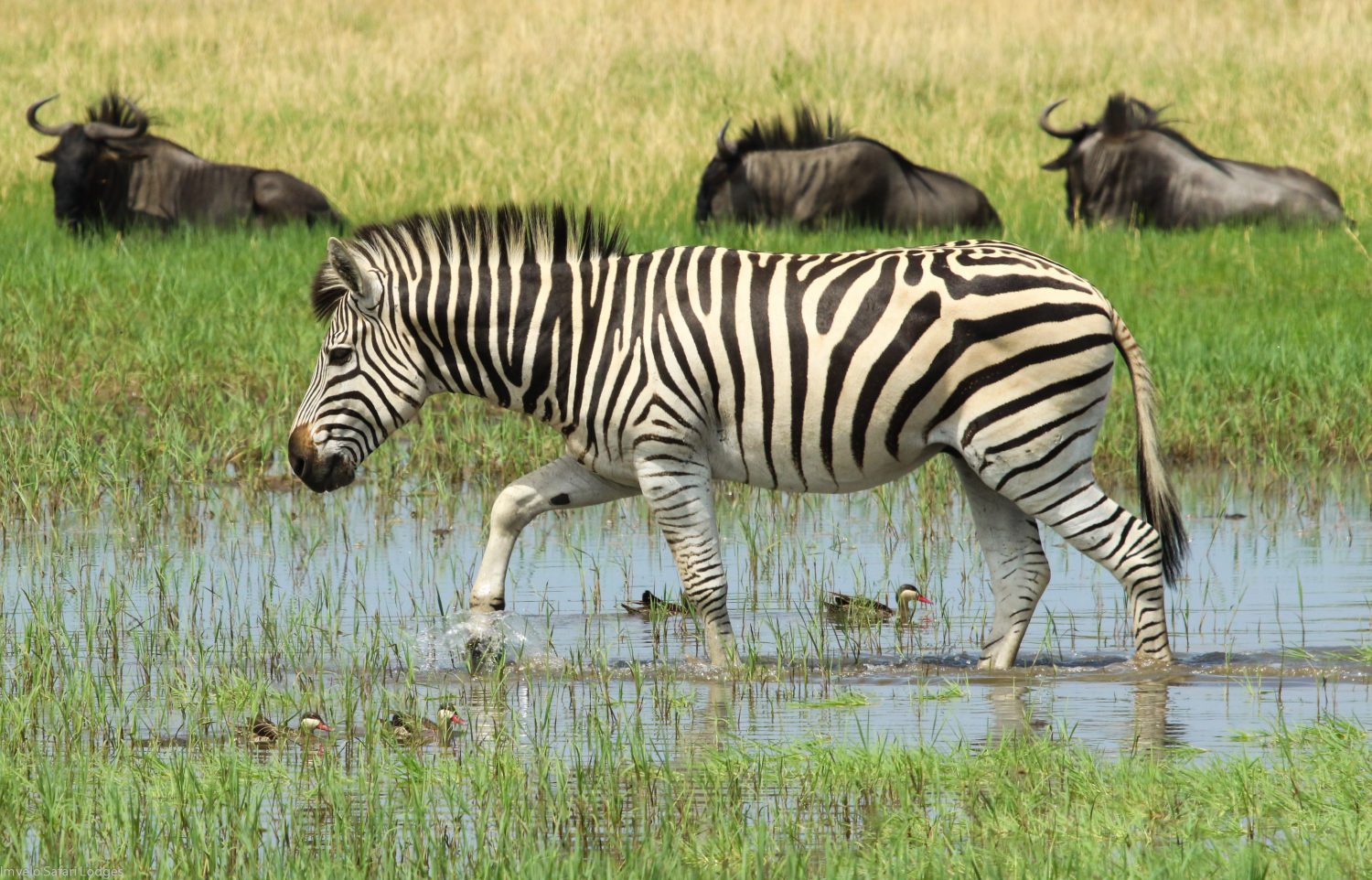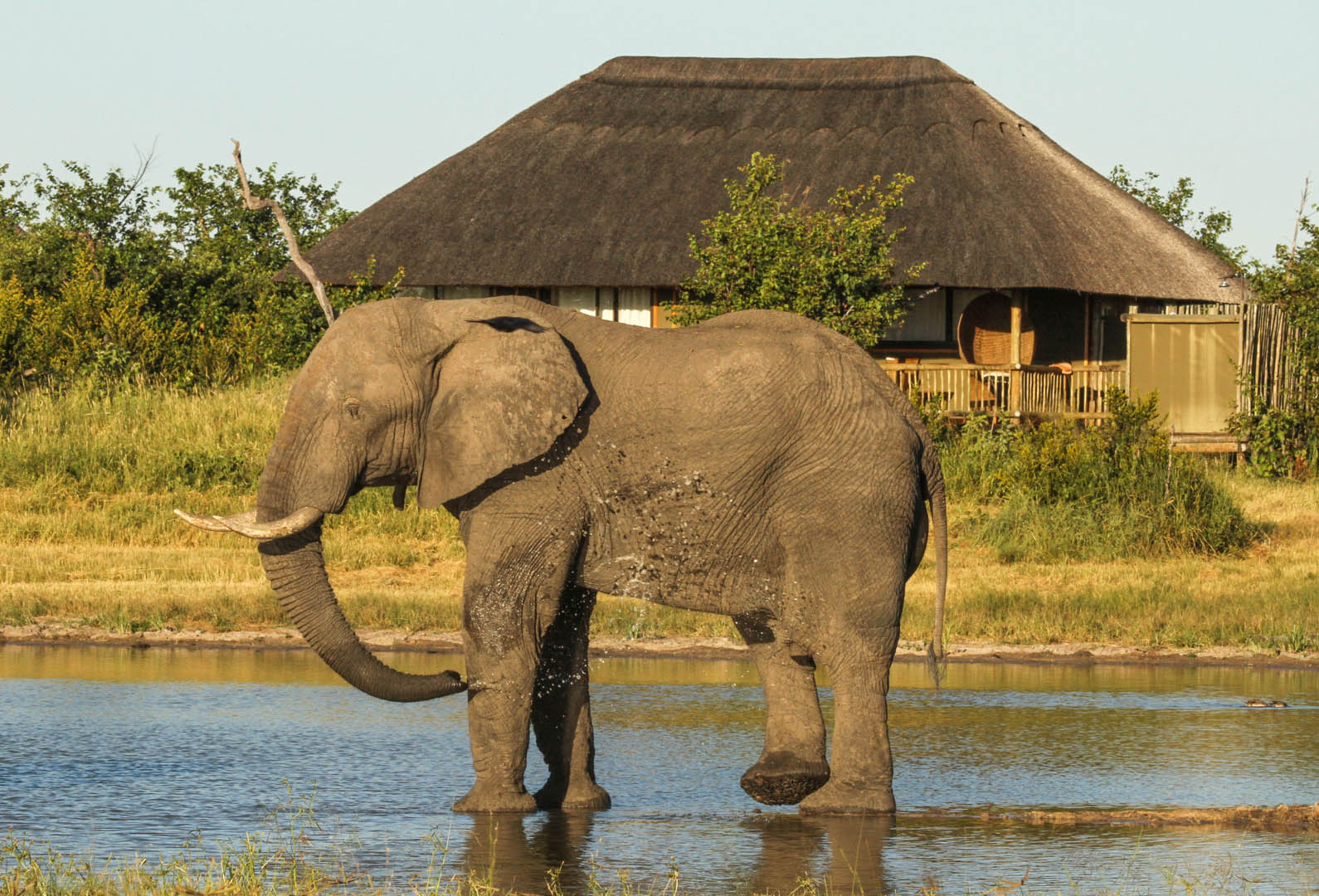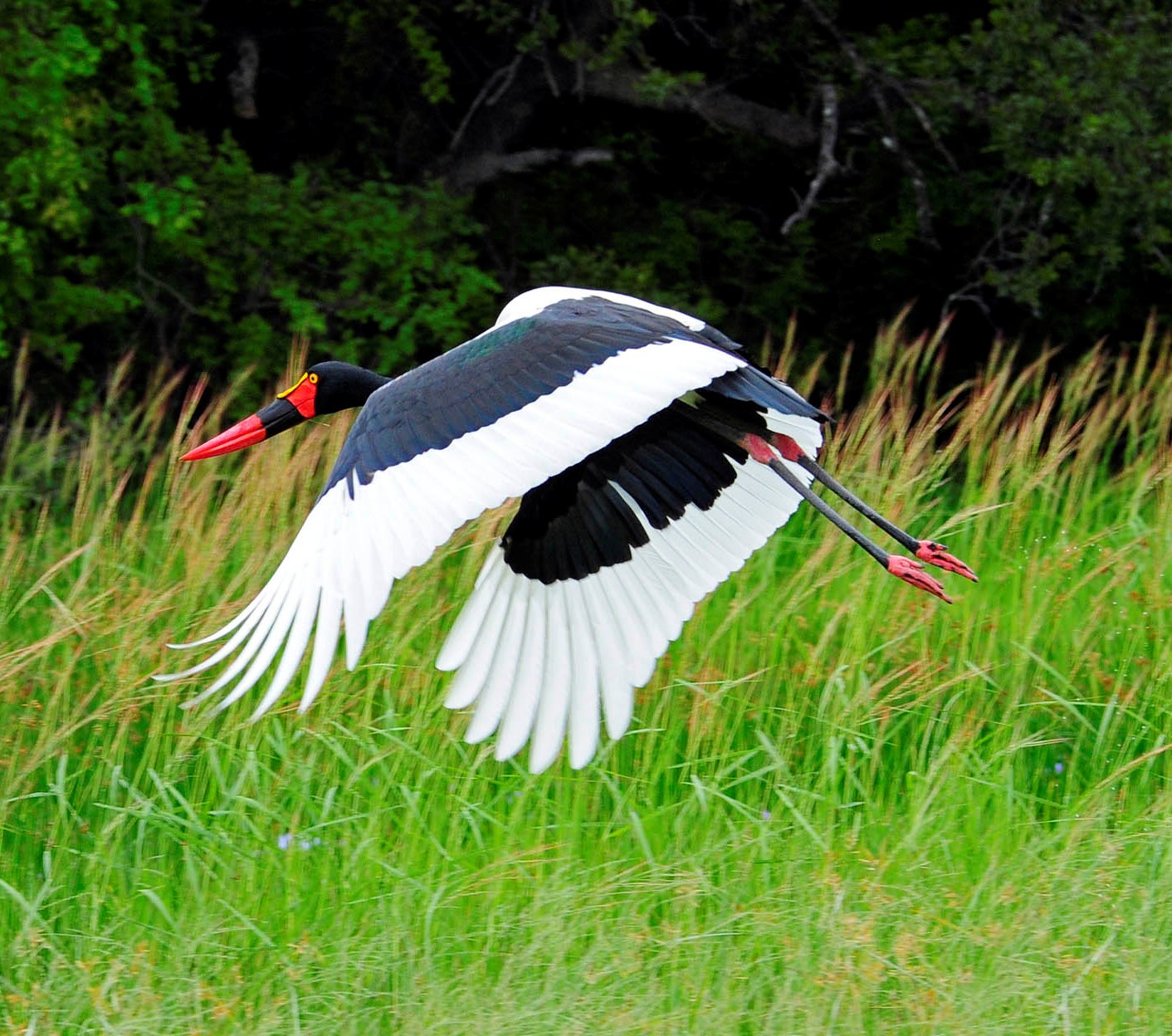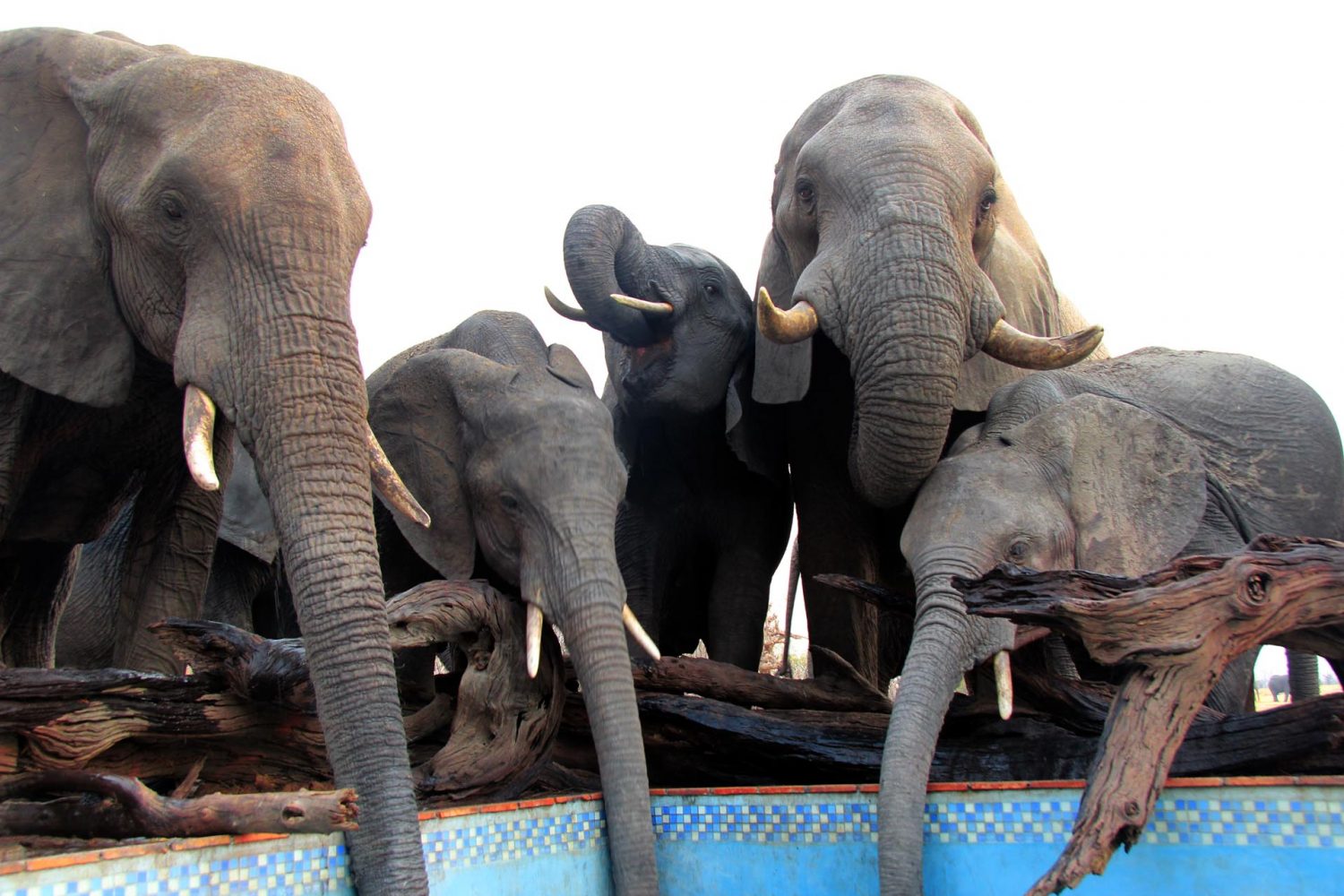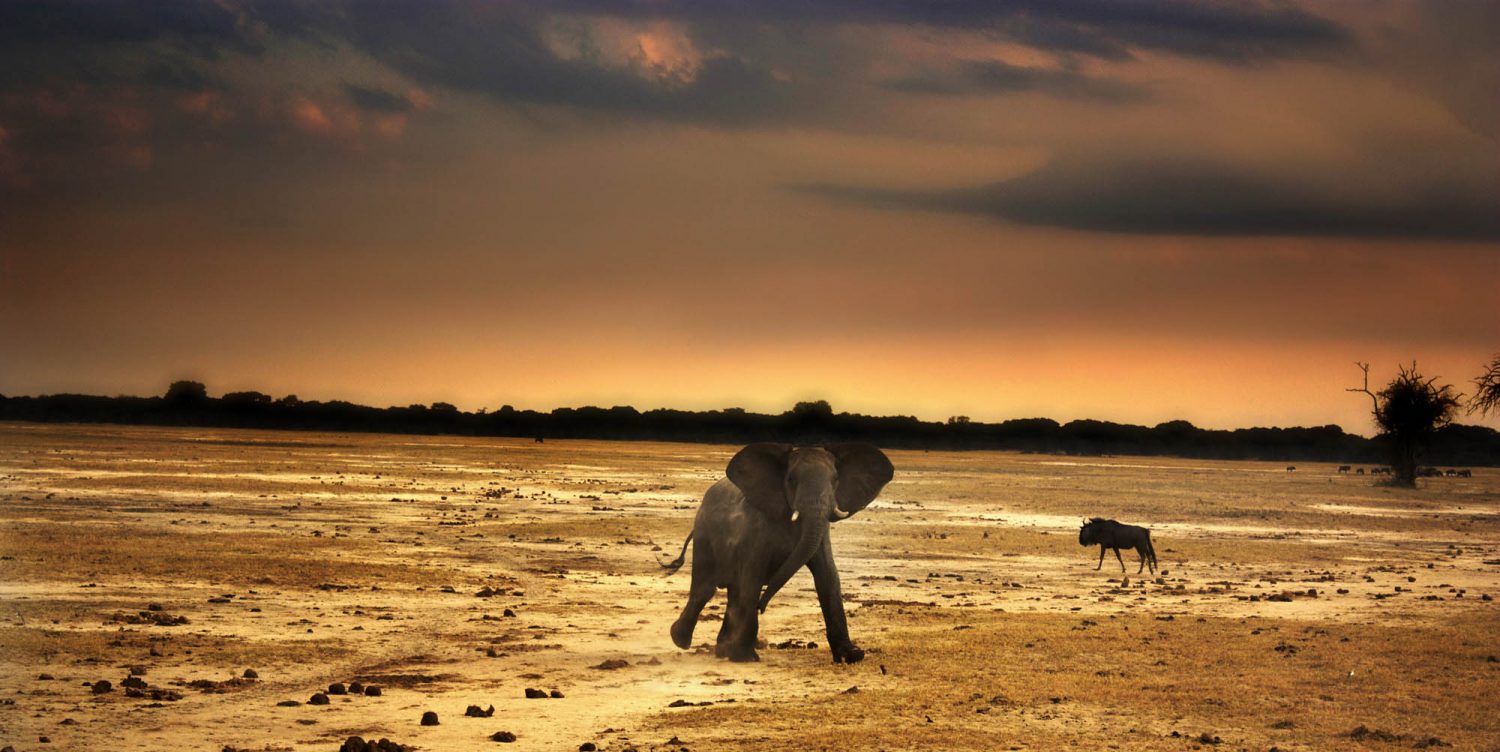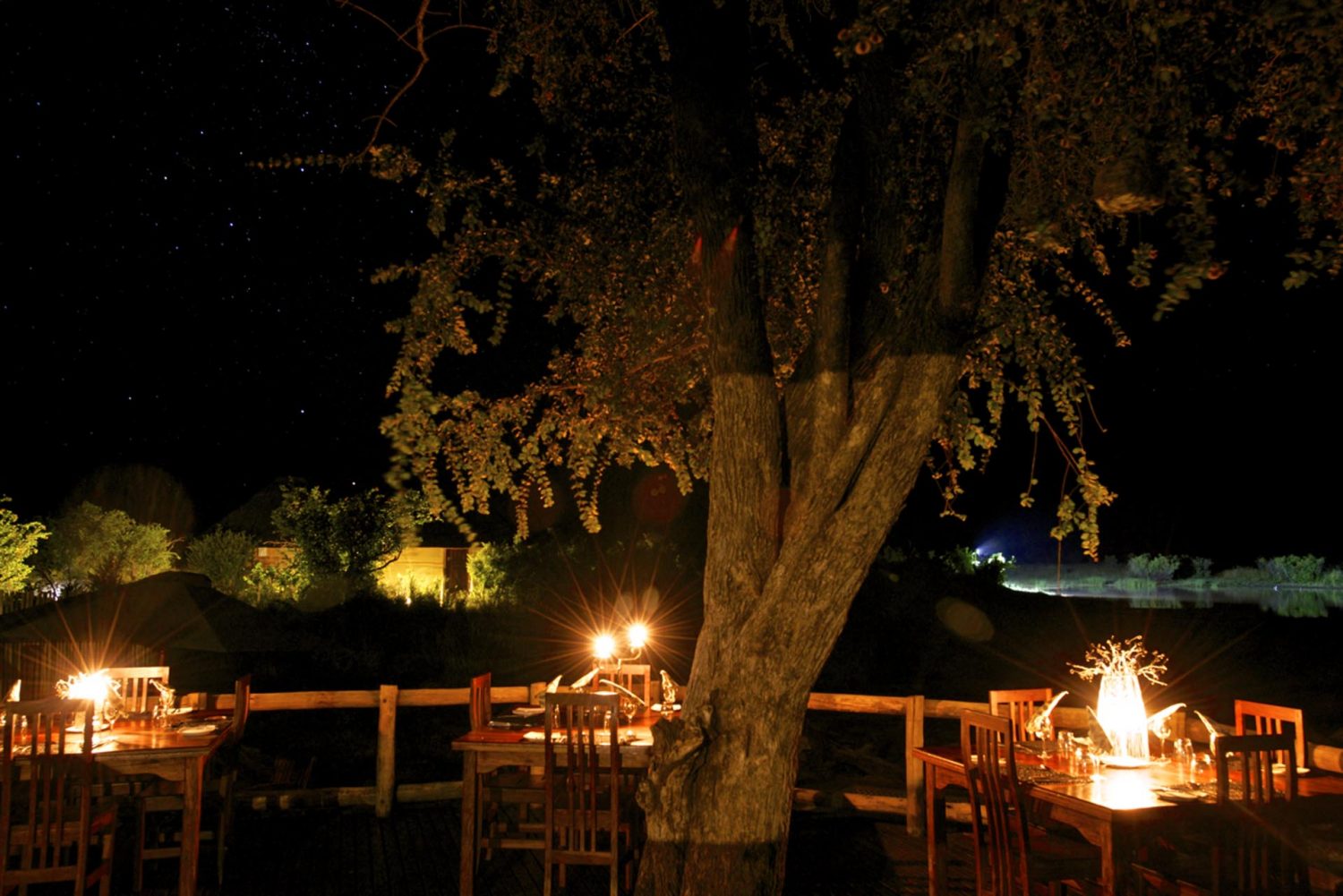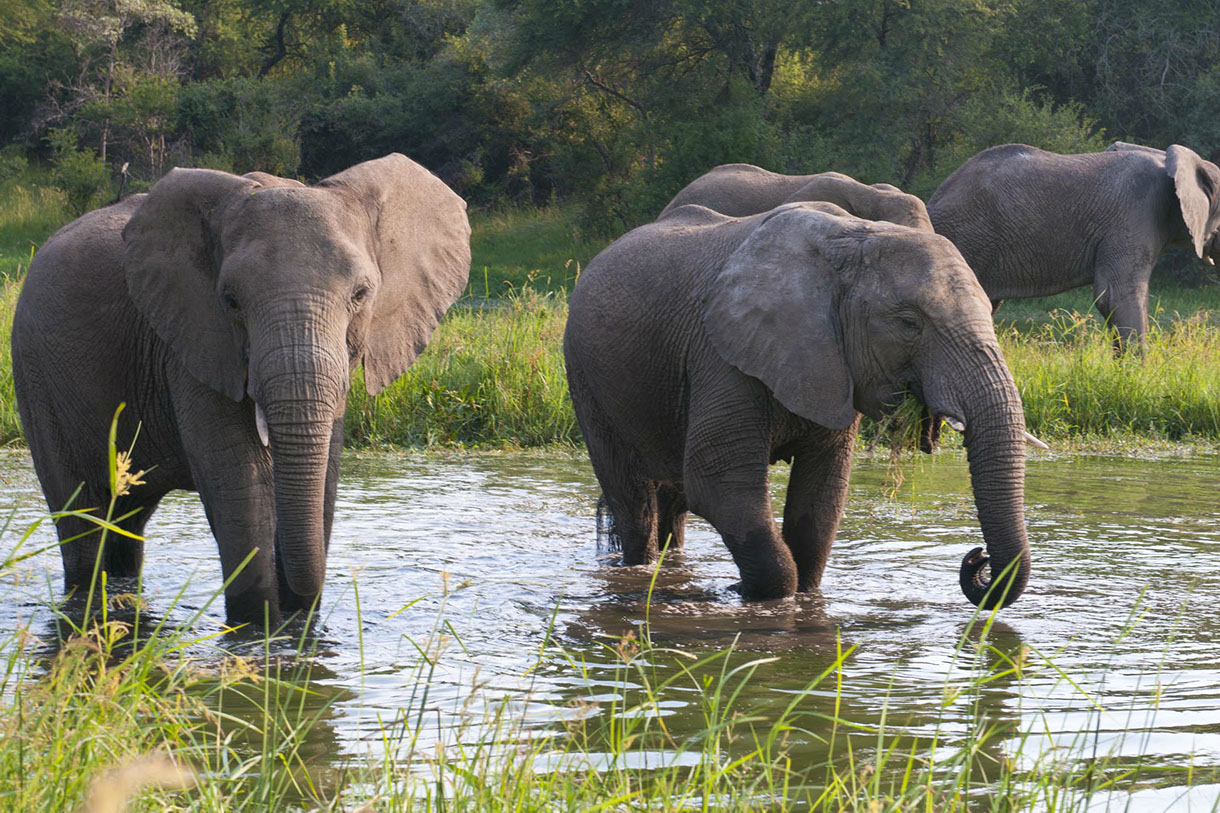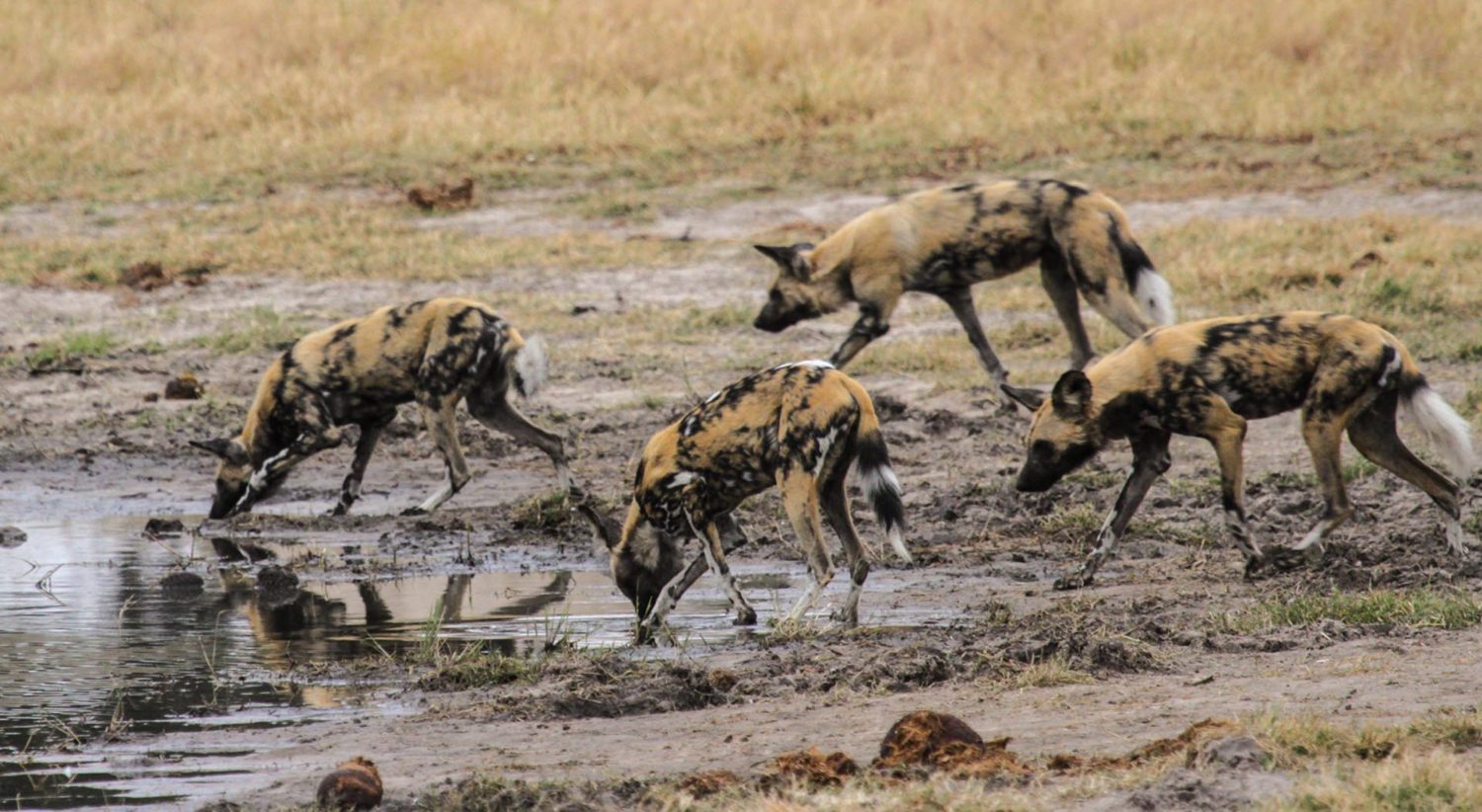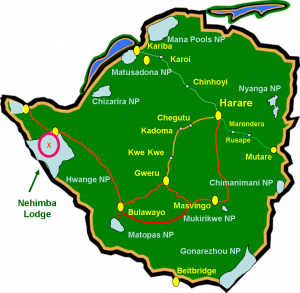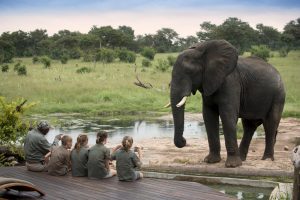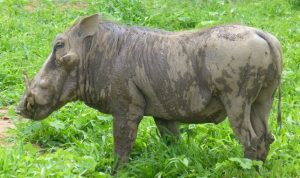Nehimba
Situated in the North West of Zimbabwe in Hwange National Park
Nehimba Lodge is situated on a large 278 sq-km private concession in the northern part of Hwange National Park. It combines luxury living, ultimate elegance and African charm to provide guests with an exceptional safari experience.
Nehimba offers seven spacious canvas under thatch tents which are built on teak decks. Together with the guest lounge area they overlook the magnificent lodge pan, which is frequented by large numbers of elephants, particularly in the dry season.
Nehimba sits firmly on the edge of the mopane woodlands associated with the north of the park and the kalahari sandveld of the south and west. All the diversity of Hwange’s fauna and flora is within easy reach. No two days are the same at Nehimba and game viewing experiences are tailor-made to our guest’s preferences, including game drives, walking safaris and night game drives on our private concession in search of nocturnal species of wildlife.
Whether guests choose to track a herd of elephant on foot with an experienced guide at dawn or spend the afternoon relaxing overlooking the waterhole on the deck by the pool, this wild and unspoilt bush paradise will guarantee that guets leave with memories to last a lifetime!
At A Glance

Accommodation
Nehimba comprises:
- 2 x Family rooms: 60 m sq with thatched roof . 1 king sized bed and 2 x ¾ beds.
- 1 x double room with day bed: 60 m sq with thatched roof
- 2 x double rooms: 57.75 m sq with thatched roof. King sized beds.
- 1 x double room: 42 m sq with thatched roof.
- 1 x twin room: 57.75 m sq with thatched roof. 2 x ¾ beds.
Note:
- All rooms overlook the waterhole.
- All the rooms have a private balcony, en-suite bathroom, outdoor shower, hot running water and electricity by generator.
- The rooms are large, airy and tastefully furnished.
- There is complimentary WiFi available in the main guest area.
Room Amenities:
- Fan
- Mosquito nets
- Mosquito repellent
- Mobile LED lamp
- Hairdryer
- Complimentary daily laundry
- Coffee and tea facilities available in the thatched tents

Activities
Activities include:
AT THE LODGE
Nehimba is situated on its own private estate within the national park and wild animals including lion, leopard, buffalo and hyena wander freely through the area.
Enjoy a steaming cup of coffee on your private balcony at dawn or relax on the guest area deck with sundowners, observing the many different animals that pass in front of the lodge and quench their thirst at the waterhole.
GAME DRIVES
Morning and afternoon game drives with snacks in traditional open safari vehicles.
All day game drives with a packed lunch and snacks in traditional open safari vehicles.
Land Cruisers seat up to 9 guests and Land Rovers seat up to 7 guests.
GAME WALKS
Conducted by a fully licensed and highly experienced professional guide.
Usually undertaken in the mornings and ideal for photography of big game on foot.
NIGHT DRIVES
For those guests who would like to view Hwange in an entirely different ‘light’, Nehimba offers guests the opportunity to accompany one of the guides on a night drive within the concession.
Filtered spotlights are used to pick out the various nocturnal species that can be found such as hyena, porcupines, civets, genet cats, and if you’re lucky, perhaps even a leopard on a hunt!
THE NEHIMBA VIEWING PLATFORM AT GRANNIES PAN
Situated close to camp, this platform is the perfect spot to marvel at the splendour of an African sunset which provides the perfect back drop to the abundance of wildlife that comes to drink at the day’s close.
VISIT THE NEHIMBA SEEPS
This is a special designated conservation area and is one of the few year-round, naturally occurring sources of surface water in the massive Hwange National Park.
The seep is an ancient source of water that was once used by the San bushmen. Today elephant visit the seep to dig for minerals and water.

Air and Road
By road from Victoria Falls: 1.5 hours on tar followed by 2-3 hours through the park.
Camp pick ups and drop offs are from Hwange Main Camp or Hwange Mbala Gate.
Self drives via Main Camp: Follow the main tar road Southeast from Victoria Falls to Bulawayo. At the 264 km peg, follow the signs West to Hwange Main Camp. Once you enter Hwange Main Camp, Nehimba is approximately 58km down the narrow tar Sinametalla Rd. You’ll pass Guvalala Pan, White Hill Pan, and eventually come to Danga Pan. At the Danga sign, turn left and follow the road about 2km to Nehimba Lodge.
Scheduled Flights:
Guests can fly into Victoria Falls and transfers can be arranged. It is approximately a three and a quarter hour road trip, 232kms (145 miles) to Somalisa Camp.
Somalisa Camp is a little over an hours drive from Hwange Main Camp.
Alternatively guests can fly into Bulawayo and it is approx four and a half hours, 349 kms (218 miles) by road to Somalisa Camp. Guests can do self drive or a transfer can be arranged for a fee.
Guests can drive to Somalisa Camp but off the main roads a 4WD is definitely recommended.
Light Aircraft:
Manga Airstrip: Situated in the heart of Hwange National Park. It is only a 30 minute drive from Somalisa Private Concession where Somalisa Camp and Somalisa Acacia are located.
Hwange Airport: It is only a 35 minute flight between Victoria Falls Airport and Hwange National air field. Somalisa Camp is 150 kms (94 miles) or approximately 2 hours and 20 minutes from Hwange airport. Transfers can be arranged
Transfers:
Victoria Falls Airport is approximately 22 kms out of Victoria Falls Town and 232 kms (145 miles) from Somalisa Camp. Pick ups from the airport can be arranged by Somalisa Camp or with local transfer companies at an additional cost.
Guests can fly into Bulawayo and it is approx four and a half hours, 349 kms (218 miles) by road to Somalisa Camp. Guests can do self drive or a transfer can be arranged for a fee.

Distances
Victoria Falls Town to Nehimba Lodge 189 kms (118 miles)
Victoria Falls Airport to Nehimba Lodge 170 kms (106.3 miles)
Livingstone Airport to Victoria Falls Town 20.6 kms (13 miles)
Livingstone airport to Nehimba Lodge 208 kms (130 miles)
Hwange Airport to Nehimba Lodge 102 kms (64 miles)
Bulawayo – Hwange 337 kms (210.63 miles)
Hwange – Victoria Falls Town 102 kms (64 miles)
Bulawayo – Nehimba Lodge 351.2 kms (219.4 miles)
Bulawayo – Victoria Falls Town 438 kms (274 miles)
Harare – Victoria Falls 878 kms (548.75 miles)
Harare – Nehimba Lodge 619 kms (387 miles)
Kariba – Victoria Falls Town 778 kms (486 miles)
Kariba – Nehimba Lodge 689 kms (430miles)
Gweru – Nehimba Lodge 451 kms (281 miles)
Gweru – Victoria Falls Town 539 kms (337 miles)
Bulawayo – Matopas 35 kms (22 miles)
Bulawayo – Beitbridge 320 kms (200 miles)
Bulawayo – Gweru 164 kms (102 miles)
Bulawayo – Harare 440 kms (274 miles)
Bulawayo – Kariba 803 kms (502 miles)
Harare – Gweru 277 kms (172 miles)

Hwange National Park
Hwange National Park (formerly called Wankie National Park) was founded in 1928 and set aside as a National Park in 1929. It was named after a local Nhanzwa chief.
Hwange became the royal hunting grounds to the Ndebele warrior-king Mzilikazi in the early 19th Century.
Hwange is the largest Park in Zimbabwe occupying approximately 14 650 square kilometers. It is located in the northwest of the country about one hour south of the town of Victoria Falls.
Hwange boasts a tremendous selection of wildlife with over 100 species of mammals and nearly 400 bird species recorded. The elephants of Hwange are world famous and the Park’s elephant population is one of the largest in the world. The Park has three distinctive Camps and administrative offices at Robins, Sinamatella and the largest one at Main Camp.
Hwange has two main seasons, one hot and wet season starting in mid November and ending in mid April. This is the season for migratory birds in Hwange ranging from the inter-African migrants like the Southern Carmine Bee-eater to the Palearctic Migrants like the Amur Falcons and the Ruff. The number of bird species found in Hwange exceeds 400 and this is largely due to migrants that take advantage of the huge numbers of insects and favourable conditions during the wet season.
The second season in the cold and dry season starting off in about mid April and ending when the rains break in mid November. The low temperatures occur for a brief period in May/June and July and then it remains dry but get progressively warmer as the season progresses. Summer temperatures can reach into the 40s whilst winter overnight lows can be in the minuses but normally for only short periods. Hwange is on the edge of the Kalahari desert and as such we see a number of desert specialist birds in this dry period such as Sand grouse, Coursers and Nightjars.

Wildlife
Animals: The Dry season (from July to October) is the best time for game viewing when animals gather around predictable water resources.
Animals include: Lion, Elephants, Hyena, Giraffes, Kudu, Sable Roan, Cheetah, Leopard Hippos, Buffalo, Zebra, Wildebeest, Wild Dogs, Hartebeest, Baboon, Impala, Warthog, Pangolins, Vervet monkeys.
Birds: Over 400 species have been recorded in Hwange which has the largest occurrence of birds in Zimbabwe.
Migratory birds are present from November to April. There are two main birding areas: the one around Main Camp and one to the north of the Park, around Robins and Sinamatella Rest Camps. Both areas are linked by a network of roads which take visitors through a variety of habitats, including many waterholes that attract large numbers of animals and birds.
Birds include: Ground Hornbill, Yellow Hornbill, Lilac Breasted Roller, Spur-winged Goose, Rufous-naped Lark, Red-billed Spurfowl, Bronze-winged Courser, Sandgrouse, Yellow-crimson Breasted Shrike, Kestrel, African Hobby, Kori Bustard, Yellow Billed Kite, Cape Griffon Vulture, Carmine Bee-eater, Martial Eagle, Pearl spotted Owlet, Swallow Tailed Bee Eater, Arnot’s Chat, Racket-tailed Roller, Crimson-breated Shrike, Red-creasted Korhaan, Secretary Bird, Kalahari scrub Robin etc

Hwange Weather
Hwange National Park weather

Weather
Monthly Averages:
- January 26°C
- February 25°C
- March 25°C
- April 23°C
- May 22°C
- June 23°C
- July 22°C
- August 23°C
- September 26°C
- October 30°C
- November 31°C
- December 31°C
Summer highs can reach 38° to 40°c
Winter lows can reach 5° to 8°c
“Words cannot describe how unbelievable this place is. The game drives were excellent along with the guide’s knowledge on everything. The guide walks were excellent. The room was very luxury! The room included a huge bed, a bathroom, and an outside shower … I felt comfortable and safe. The food was delicious and never ending. I cannot wait to go back!.“
” I cannot say enough about this amazing lodge, the staff and the entire safari experience at Nehimba. Our guide Brendan was great!! It was always an adventure when we were out on our game drives with him… Whether spotting several dozen lions in one day, approaching wild dogs after a kill…The food was amazing.”
“…a fantastic place to go to. First of all I had a very good guide… we saw an incredible lot of game, even one time a pride of 16 lions! Of course lots of elephants as well…Nehimbe is situated in a beautiful part of the park and really in the bush. Perfect food. Staff really do take care of you very well. Highly recommended! “
“We spent three days in October …during the dry season. It was just perfect! Hundreds of elephants and other animals….We love our stay every minute. The family accommodation was stunning very nice and comfortable. It was a real adventure for all of us. The staff at Nehimba is wonderful very well trained … The food was nice and tasty. We still have nice dreams about Nehimba…..We would love to go back another time”
“We stayed at Nehimba for 3 nights as part of our safari holiday and WOW – what place. We are seasoned safari goers and have stayed in some ‘wild’ un fenced places but this was fantastic. Elephants EVERY day come into camp to drink from the waterhole along with buffalo, and on one occasion 4 wild dogs! The evening is when it comes into it’s own with elephants everywhere – there are lots and they all come to drink from the camp swimming pool!!!.”
“… we were not prepared for the experience we had at the Nehimba Lodge. …Nehimba is really excellent. Its far away from the entrance, real isolated, has its own waterhole in front of the lodges and during dry season we had more than 45-50 elephants, buffaloes, hyenas, lions and many others literally around us. Lions were sleeping under our lodge during night; the elephants were playing all day long with the small swimming pool of the lodge…the staff was friendly and helpful, the food was very good and tasty, and the guides very knowledgeable. “

